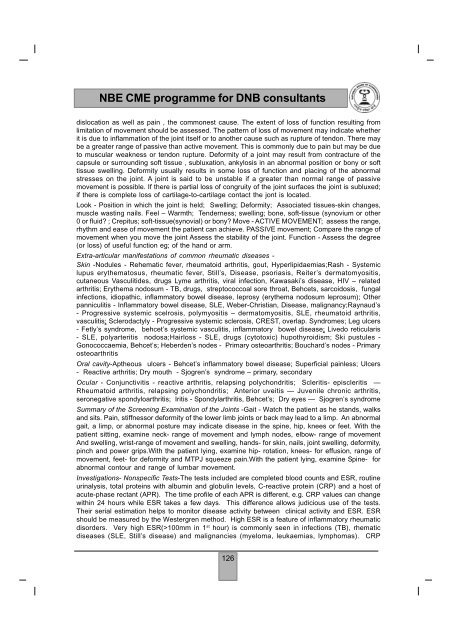NBE CME programme for DNB consultants - National Board Of ...
NBE CME programme for DNB consultants - National Board Of ...
NBE CME programme for DNB consultants - National Board Of ...
You also want an ePaper? Increase the reach of your titles
YUMPU automatically turns print PDFs into web optimized ePapers that Google loves.
<strong>NBE</strong> <strong>CME</strong> <strong>programme</strong> <strong>for</strong> <strong>DNB</strong> <strong>consultants</strong>dislocation as well as pain , the commonest cause. The extent of loss of function resulting fromlimitation of movement should be assessed. The pattern of loss of movement may indicate whetherit is due to inflammation of the joint itself or to another cause such as rupture of tendon. There maybe a greater range of passive than active movement. This is commonly due to pain but may be dueto muscular weakness or tendon rupture. De<strong>for</strong>mity of a joint may result from contracture of thecapsule or surrounding soft tissue , subluxation, ankylosis in an abnormal position or bony or softtissue swelling. De<strong>for</strong>mity usually results in some loss of function and placing of the abnormalstresses on the joint. A joint is said to be unstable if a greater than normal range of passivemovement is possible. If there is partial loss of congruity of the joint surfaces the joint is subluxed;if there is complete loss of cartilage-to-cartilage contact the jont is located.Look - Position in which the joint is held; Swelling; De<strong>for</strong>mity; Associated tissues-skin changes,muscle wasting nails. Feel – Warmth; Tenderness; swelling; bone, soft-tissue (synovium or other0 or fluid? ; Crepitus; soft-tissue(synovial) or bony? Move - ACTIVE MOVEMENT; assess the range,rhythm and ease of movement the patient can achieve. PASSIVE movement; Compare the range ofmovement when you move the joint Assess the stability of the joint. Function - Assess the degree(or loss) of useful function eg; of the hand or arm.Extra-articular manifestations of common rheumatic diseases -Skin -Nodules - Rehematic fever, rheumatoid arthritis, gout, Hyperlipidaemias;Rash - Systemiclupus erythematosus, rheumatic fever, Still’s, Disease, psoriasis, Reiter’s dermatomyositis,cutaneous Vasculitides, drugs Lyme arthritis, viral infection, Kawasaki’s disease, HIV – relatedarthritis; Erythema nodosum - TB, drugs, streptococcoal sore throat, Behcets, sarcoidosis, fungalinfections, idiopathic, inflammatory bowel disease, leprosy (erythema nodosum leprosum); Otherpanniculitis - Inflammatory bowel disease, SLE, Weber-Christian, Disease, malignancy;Raynaud’s- Progressive systemic scelrosis, polymyositis – dermatomyositis, SLE, rheumatoid arthritis,vasculitis; Sclerodactyly - Progressive systemic sclerosis, CREST, overlap. Syndromes; Leg ulcers- Fetly’s syndrome, behcet’s systemic vasculitis, inflammatory bowel disease; Livedo reticularis- SLE, polyarteritis nodosa;Hairloss - SLE, drugs (cytotoxic) hupothyroidism; Ski pustules -Gonococcaemia, Behcet’s; Heberden’s nodes - Primary osteoarthritis; Bouchard’s nodes - PrimaryosteoarthritisOral cavity-Aptheous ulcers - Behcet’s inflammatory bowel disease; Superficial painless; Ulcers- Reactive arthritis; Dry mouth - Sjogren’s syndrome – primary, secondaryOcular - Conjunctivitis - reactive arthritis, relapsing polychondritis; Scleritis- episcleritis —Rheumatoid arthritis, relapsing polychondritis; Anterior uveitis — Juvenile chronic arthritis,seronegative spondyloarthritis; Iritis - Spondylarthritis, Behcet’s; Dry eyes — Sjogren’s syndromeSummary of the Screening Examination of the Joints -Gait - Watch the patient as he stands, walksand sits. Pain, stiffnessor de<strong>for</strong>mity of the lower limb joints or back may lead to a limp. An abnormalgait, a limp, or abnormal posture may indicate disease in the spine, hip, knees or feet. With thepatient sitting, examine neck- range of movement and lymph nodes, elbow- range of movementAnd swelling, wrist-range of movement and swelling, hands- <strong>for</strong> skin, nails, joint swelling, de<strong>for</strong>mity,pinch and power grips.With the patient lying, examine hip- rotation, knees- <strong>for</strong> effusion, range ofmovement, feet- <strong>for</strong> de<strong>for</strong>mity and MTPJ squeeze pain.With the patient lying, examine Spine- <strong>for</strong>abnormal contour and range of lumbar movement.Investigations- Nonspecific Tests-The tests included are completed blood counts and ESR, routineurinalysis, total proteins with albumin and globulin levels, C-reactive protein (CRP) and a host ofacute-phase rectant (APR). The time profile of each APR is different, e.g. CRP values can changewithin 24 hours while ESR takes a few days. This difference allows judicious use of the tests.Their serial estimation helps to monitor disease activity between clinical activity and ESR. ESRshould be measured by the Westergren method. High ESR is a feature of inflammatory rheumaticdisorders. Very high ESR(>100mm in 1 st hour) is commonly seen in infections (TB), rhematicdiseases (SLE, Still’s disease) and malignancies (myeloma, leukaemias, lymphomas). CRP126
















